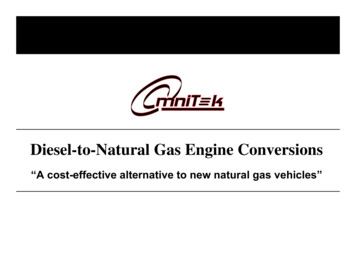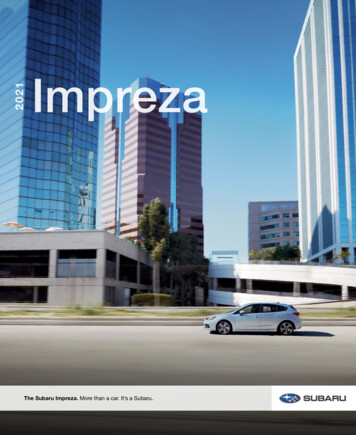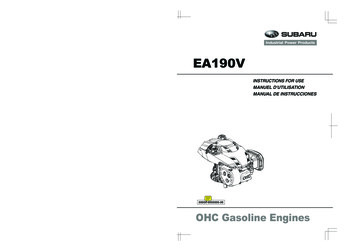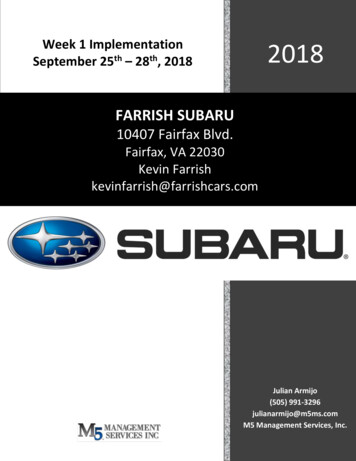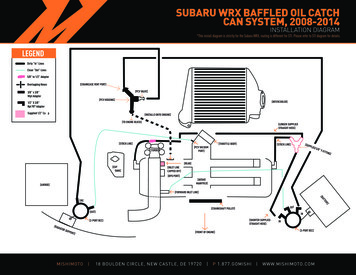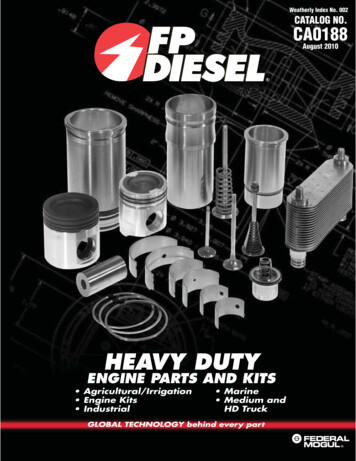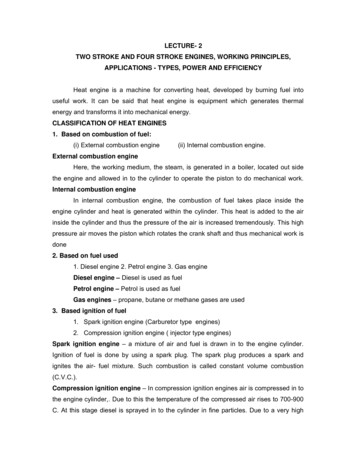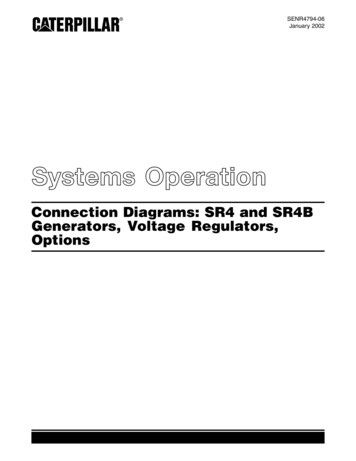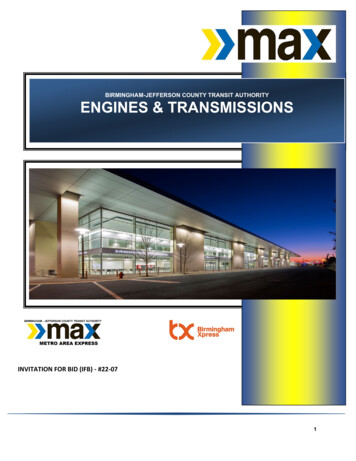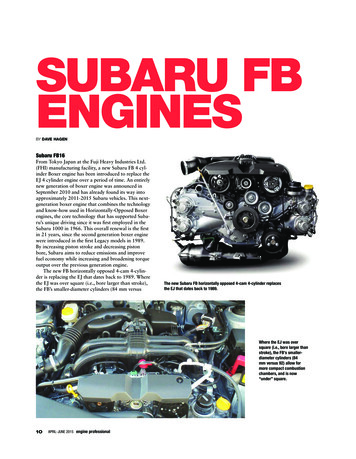
Transcription
SUBARU FBENGINESBY dave hagenSubaru FB16From Tokyo Japan at the Fuji Heavy Industries Ltd.(FHI) manufacturing facility, a new Subaru FB 4 cylinder Boxer engine has been introduced to replace theEJ 4 cylinder engine over a period of time. An entirelynew generation of boxer engine was announced inSeptember 2010 and has already found its way intoapproximately 2011-2015 Subaru vehicles. This nextgeneration boxer engine that combines the technologyand know-how used in Horizontally-Opposed Boxerengines, the core technology that has supported Subaru’s unique driving since it was first employed in theSubaru 1000 in 1966. This overall renewal is the firstin 21 years, since the second generation boxer enginewere introduced in the first Legacy models in 1989.By increasing piston stroke and decreasing pistonbore, Subaru aims to reduce emissions and improvefuel economy while increasing and broadening torqueoutput over the previous generation engine.The new FB horizontally opposed 4-cam 4-cylinder is replacing the EJ that dates back to 1989. Wherethe EJ was over square (i.e., bore larger than stroke),the FB’s smaller-diameter cylinders (84 mm versusThe new Subaru FB horizontally opposed 4-cam 4-cylinder replacesthe EJ that dates back to 1989.Where the EJ was oversquare (i.e., bore larger thanstroke), the FB’s smallerdiameter cylinders (84mm versus 92) allow formore compact combustionchambers, and is now“under” square.10APRIL-JUNE 2015 engine professionalEP Q215 1-96.indd 103/20/15 10:09 AM
subaru fb enginesBY dave hagenThe cylinder heads and the camshaft carriersconsist of separate pieces instead of one metalcasting, which allows a reduction in metalthickness, simplification of the engine’s structure,and reduction in weight.The all new FB Cylinder Head92) allow for more compact combustionchambers, and is now “under” square.The trick was to increase the stroke ofthe crankshaft (now 90 mm versus 75),yet not increase the width of the longitudinally mounted engine allowing it to fitinto the present Subaru vehicles. The solution was swapping the camshafts’ beltdrive for chain drive (and consequently,bulkier pulleys for smaller sprockets).The valve angle was reduced too, from41 degrees to 27—further shrinking thesize of the combustion chamber. Forlower friction, cam lobes now ride onroller tappets and cylinder-bore roundness was improved, allowing for lowertension piston rings. The intake systemhas been totally reworked to include aplastic plenum/runners assembly andfour butterfly valves (in addition to thesingle throttle body) to enhance cylinderfilling or promote tumble when needed.The resulting Upshot? It’s about the samepower as before in both 2.0- and 2.5-literiterations, but slightly more midrangetorque, sweeter air out the tailpipe and,on average, about 10 percent better fueleconomy which is a win-win for everyone.The FB has an all new block andcylinder heads featuring dual overheadcams with intake and exhaust vari12able valve timing (AVCS - Active ValveControl System), and a timing chainthat replaced the timing belt. Moving tochain-driven cams is said to allow thevalves to be placed at a narrower angleto each other and shrink the bore ofcylinder from 99.5 mm to 94. It resultsin less unburned fuel during cold starts,thereby reducing emissions. Subaru isable to maintain the exterior dimensionsubstantially unchanged by asymmetricalconnecting rods like those in EZ36. TheFB is only marginally heavier. Subaruclaims a 28-percent reduction in friction losses, mainly due to lighter pistonsand connecting rods. The FB has a 10%improvement in fuel economy with thepower coming on sooner and the torqueband being broader and it’s no doubtdirect injected fuel is planned soon.Despite the longer stroke, engineerswere able to maintain the dimensions ofthe EJ engine with revisions to connecting rods and valve train components.Maintaining engine width was a concernin designing the FB power plant. Thenew engine was required to fit in thesame-sized engine bay as its predecessor.The change in the combustion chamber’sdisplacement and surface area helps toreduce engine knock.CYLINDER HEADS/CAM CARRIERSThe cylinder heads and the camshaft carriers consist of separate pieces instead ofone metal casting. That allows a reduction in metal thickness, simplification ofthe engine’s structure, and reduction inweight.Revisions to the valve train includethe use of roller rocker arms instead oflifters to actuate valves. These components and their layout contribute toreducing the width of the cylinder headsand overall engine width.The fuel injectors were moved to thecylinder heads. In the EJ engine, theywere mounted in the intake manifolds.The relocation enhances the flow ofatomized fuel, helping to improve fuelefficiency and reduce exhaust gas emissions.INTAKE AND EXHAUSTBoth intake and exhaust systems are designed to optimize the flow of gases andimprove performance.In the intake system, the intake manifold no longer requires a large intakechamber, which reduces the number ofparts in the engine. The size and shape ofthe large and small resonators along theintake manifold are streamlined. Theserevisions help reduce overall engineweight as well as manufacturing costs.Another modification resulting inthe elimination of parts is the additionof a cooling function to the exhaust gasrecirculation system.Intake and exhaust ports and valveshave been revised, too. Valves have beenengineered to reduce drops in pressurewhen they’re open, which helps improveperformance. Their design increases tumbling (keeping fuel mixed with air) whenclosed, which improves fuel efficiencyand helps reduce exhaust gas emissions.APRIL-JUNE 2015 engine professionalEP Q215 1-96.indd 123/20/15 10:09 AM
The exhaust system features improvedtuning. The diameters and lengths ofthe separate tubes have been modifiedto improve catalytic converter warmup (reducing emissions) and to increasepower output.LIGHTWEIGHT COMPONENTSAmong the components redesigned toweigh less in the FB engine are: Connecting rods shaped to help keepengine width the same as the EJ whileallowing longer stroke Pistons with a smaller bore, requiringless material and having less reciprocating mass Wrist pins with smaller diameters,requiring less materialABOVE: FB vs. EJ Exhaust Systems —The FB exhaust system features improvedtuning. The diameters and lengths of theseparate tubes have been modified to improvecatalytic converter warm-up (reducingemissions) and to increase power output.Along with an efficient and compactoil pump, the lightweight componentsreduce friction loss by approximately 30percent, improving fuel efficiency andengine response.(continued)LEFT: FB vs. EJ Connecting Rods —Connecting rods for the FB engine have beenredesigned to weigh less and are shaped to helpkeep engine width the same as the EJ whileallowing longer stroke.Don’t Build Another EngineWITHOUT DRIVEN PROTECTIONDRIVEN HAS ENGINEERED A SYSTEM OF OILS THATPUTS THE “MOTOR BEFORE THE MOLECULE”The Driven system of lubricants provides layers of ZDDP protection for high performanceengines and flat tappet camshafts. Zinc additives react under heat and load to create asacrificial film and are not all the same. Driven has the correct “fast burn” additives thatactivate quickly. From assembly to break-in, Driven products work together to rapidly establish that critical anti-wear film.HVL - HIGH VISCOSITY LUBRICANTEstablishes a protective ZDDP-fortified, non-foaming fluid film that mixes with the break-in oil,extending oil thickness during break-in. Does not harden or cause parts to become “sticky.”Perfect for engine bearings, piston skirts, bushings, timing chain assemblies and oil pumps.ENGINE ASSEMBLY GREASEClings to and protects surfaces during initial start-up, this unique extreme pressure lube dissolves completely in oil without clogging passageways or filters. Perfect for not only cams andlifters, but also distributor gears, rocker shafts and tips, pushrod tips, wrist pins and valve guides.BR BREAK-IN OIL1.866.611.1820 DRIVENRACINGOIL.COMJoin Us:9591jOptimum Zinc and Phosphorus levels for flat tappet and aggressive roller valve trains withan additive package that promotes ring seal. Does not require ZDDP additives. Also great fordyno testing, one night of racing or 400 miles on the street.#DRIVENTOWINwww.engineprofessional.comEP Q215 1-96.indd 13133/20/15 10:09 AM
subaru fb enginesBY dave hagenCHAIN DRIVEThe double overhead camshafts aredriven by chains rather than toothedbelts. The chains are maintenance freeand do not require replacement, helpingto lower the cost of ownership.The use of chain drive allows smallersprocket diameters at the crankshaft andcamshafts. That helps to keep enginewidth within convenient dimensions.FB VERSUS EJAs compared with the previous nonturbocharged EJ25 engine, the FB25produces: The same horsepower, but at lower rpm Slightly higher torque at lower rpm Improved fuel economyThe double overhead camshafts are drivenby chains rather than toothed belts.That makes the Forester’s new FBSUBARU BOXER engine more responsive, especially at lower engine speeds,while allowing the vehicle to travelfarther on the same amount of fuel.(continued)14APRIL-JUNE 2015 engine professionalEP Q215 1-96.indd 143/20/15 10:09 AMAERA E
subaru fb enginesBY dave hagenAs compared with the previous non-turbochargedEJ25 engine, the FB25 produces the same horsepower,but at lower rpm, slightly higher torque at lower rpmand improved fuel economy. That makes the Forester’snew FB SUBARU BOXER engine more responsive,especially at lower engine speeds, while allowing thevehicle to travel farther on the same amount of fuel.FB VERSUS EJ2011 FB2010 EJDisplacement, cc (cu in)2,498 (152)2,457 (150)Bore/stroke, mm (in)94.0/90.0 (3.70/3.54)99.5/79.0 (3.92/3.11)Peak horsepower, @ rpm170 @ 5,800 rpm170 @ 6,000 rpmPeak torque, lb-ft @ rpm174 @ 4,100 rpm170 @ 4,400 rpmCompression ratio, :110.510.0Fuel requirementUnleaded gasoline(87 octane)Unleaded gasoline(87 octane)Valve train configuration16-valve, doubleoverhead camshaft16-valve, singleoverhead camshaftThe FB engine is currently offered in three displacementswith room for more options in the future. FB16: 1,600 cc, DOHC, 78.8 mm bore x 82 mm stroke, 10.5:1Compression Ratio, Rated at: 84 kW (115PS) @5,600 rpm,150 Nm (15.3 kgm) @4,000 rpm in (2012 EUDM ImprezaXV 1.6i)Every new engine comes with some issues after their launchinto the real world of reality and these engines will offer continued service work for technicians worldwide and there’s beensome problems with oil ring seal for select models. Subaru ishandling the concerns on an individual basis and has a genuinegoal of maintaining customer satisfaction for a well-respectedvehicle brand. Head gasket issues are starting to occur as themileages are starting to get up near or beyond the 100,000 markwhich offers more opportunities form machine shops. Performance parts for these engines are also very limited at the time ofthis article, but, I’m sure they’re in the planning stages somewhere. The next improvement for this engine could very well bedirect injection as Subaru has been developing GDI for the pastfew years. n FB20B: 1,995 cc, DOHC, 84 mm bore x 90 mm stroke, 10.5:1Compression Ratio, Rated at: 109 kW (148PS) @6,000 rpm,196 Nm (20 kgm) @4,200 rpm in (2011 JDM Subaru Forester) Rated at: 148 hp, 145 lb·ft (2012 Subaru Impreza andSubaru XV) FB20X: 1,995 cc, DOHC, 84 mm bore x 90 mm stroke, 10.5:1Compression Ratio Rated at: 148 hp, 145 lb·ft (2014 SubaruXV Hybrid) FB25B: 2,498 cc, DOHC, 94 mm bore x 90 mm stroke, 10.0:1Compression Ratio. Rated at: 170 hp, 174 lb·ft @ 4,100rpm (2011 North American Subaru Forester, 2012 NorthAmerican Subaru Legacy)16AERA Technical Specialist Dave Hagen has over 41 years ofexperience in our industry. As an ASE-certified Master Machinist,Dave specialized in cylinder head work and complete engineassembly for the first 17 years of his career.APRIL-JUNE 2015 engine professionalEP Q215 1-96.indd 163/20/15 10:09 AMElgin-EP
SUBARU FB ENGINES BY DAve hAgen Where the EJ was over square (i.e., bore larger than stroke), the FB's smaller-diameter cylinders (84 mm versus 92) allow for more compact combustion chambers, and is now "under" square. The new Subaru FB horizontally opposed 4-cam 4-cylinder replaces the EJ that dates back to 1989.

